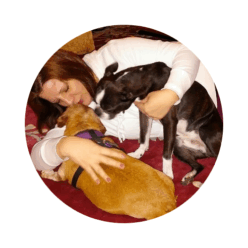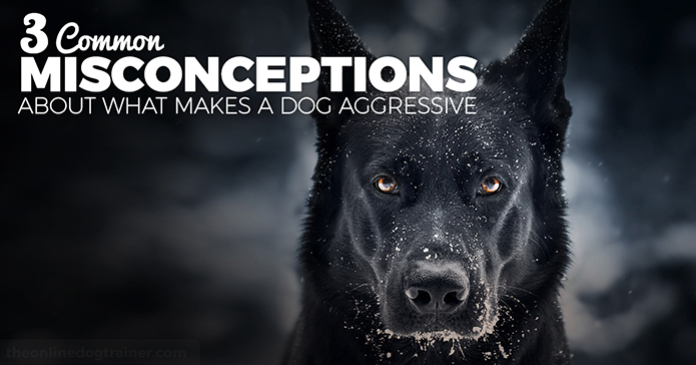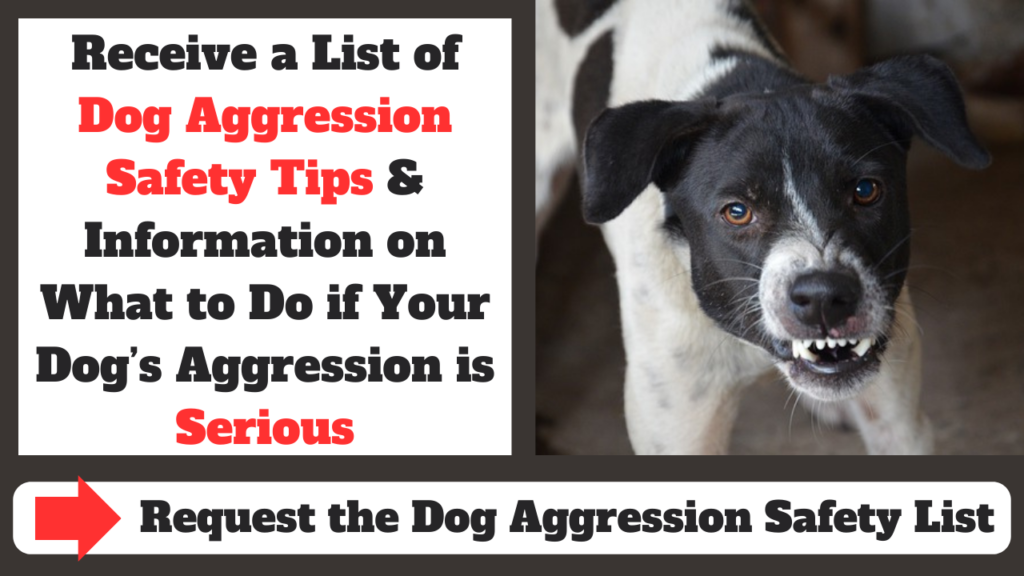You may have heard these 3 common misconceptions about dog aggression:
1. Males are more aggressive
2. Larger dogs are more aggressive
3. Certain breeds are more aggressive.
This post contains affiliate links. If you make a purchase, I’ll earn a commission (at no extra cost to you). As an Amazon Associate, I earn from qualifying purchases. I donate 10% of my earnings to animal charities.
Here’s the Truth About Dog Aggression
It’s likely you’ve come across a story about someone getting attacked by a dog on the news or in a newspaper. Most of the time, it seems the dog is male, large, and may be a specific breed like a German Shepherd or a Pit Bull.
While the stories are undoubtedly true, you do have to realize the fact that these are the stories being reported because someone got hurt, and because they tend to solidify common misconceptions about dog aggression.
The Real Cause of Dog Aggression
We’ll be discussing the common misconceptions about dog aggression in this post. But first, listen as Professional Dog Trainer and Behavioral Specialist, Doggy Dan, owner of the dog training website, TheOnlineDogTrainer.com, explains exactly what happens in a dog’s brain when they’re behaving aggressively. You’ll be shocked when you realize what’s really going on!
Watch My Video: 3 Common Misconceptions ABout Dog Aggression
What Makes a Dog Aggressive? 3 Common Misconceptions
1. Aggressive dogs are mostly males. We tend to think of females as gentler and nurturing than males. And we tend to think of males as more dominant.
Doggy Dan ran a simple quiz with the owners of nearly 30,000 aggressive dogs and puppies and found that 56% of them were male and 44% were female. Nearly half of them were female!
Some people think that male dogs are more aggressive because of testosterone. A study from Psychology Today looked at whether male or female dogs are more aggressive and found that males being more aggressive is not accurate at all.
The study said, “Science does not find that the issue of sex differences in aggression is simple and always predictable when it comes to dogs.”
When it comes to dog-on-dog aggression, it is true that male dogs tend to be more challenging toward each other, whereas female dogs tend to be less threatening in such circumstances. But overall, female dogs are more stubborn, independent and territorial than male dogs.
Bottom line: Both male and female dogs can be aggressive.
2. Large dogs are the most aggressive. I personally owned a miniature dachshund named Maggie who would violently attack any other dog the moment she saw it. Her behavior was ridiculous! I had to pick her up and hold onto her whenever another dog approached.
So as far as I’m concerned, that alone takes the concept that only large dogs are aggressive and tosses it right out the window!
In reality, the main reason why people think large dogs are more aggressive is because those are the only incidents that are reported and talked about. If someone gets nipped on the ankle by a Chihuahua, it’s not going to make the news. Whereas, when someone gets bitten by a Pit Bull, the news of it is all over the place.
Attacks by smaller dogs don’t generally result in injury, whereas larger dogs can actually hurt people and animals. What you might actually find quite shocking is that smaller dogs tend to be more aggressive than larger dogs.
A study from the University of Veterinary Medicine in Vienna surveyed 1,276 people who owned dogs of varying sizes and discovered that, overall, small dogs were less obedient, more excitable, more likely to growl or bark at strangers or other dogs and were more fearful and anxious than larger dogs.
These issues can definitely be addressed with training. However, these traits can, in fact, trigger aggression.
3. Certain breeds are more aggressive. This is the biggest misconception about dog aggression. A dog’s breed is like a person’s race.
There are gentle and calm people in every race, and there are aggressive and violent people in every race. The same is true of dog breeds.
One of the most commonly stereotyped dog breeds is the Pit Bull. Yes, there are many reported cases of people being attacked and injured, or even killed, by Pit Bulls.
But what isn’t reported is that many of these attacks occur because this particular breed is often purposely mistreated and sometimes trained to fight and be aggressive.
The behavior has very little to do with the breed itself; rather, it has to do with the way the dog is treated and taught by the owner. Take the very same dog and put him a loving home as a puppy, and he’ll be a totally different dog.
There was a study done by Rachel Casey, a researcher at the University of Bristol’s School of Veterinary Sciences. “Casey sent out 15,000 questionnaires to dog owners. About 4,000 people sent them back. Analyzing their responses, Casey found that certain traits of an owner said more about a dog’s aggression than the dog’s breed could.
For example, dogs with owners under 25 were almost twice as likely to be aggressive than dogs with owners over forty.
Unsurprisingly, dogs who attended puppy-training classes were half as likely to be aggressive to strangers. Owners who trained their dogs using punishment and negative reinforcement wound up with a dog twice as likely to be aggressive towards strangers, and three times as likely to lunge at family members.”
As you can see, there is evidence that the behavior of Pit Bulls has nothing to do at all with their breed. It very possibly has far more to do with the owner.
If you’d like more information about Pit Bulls being unfairly stereotyped as aggressive, check out my article, How to Help Pit Bulls – They Need Us to Defend Them!
Free Dog Aggression Tutorial
Professional Dog Trainer and Behavioral Specialist, Doggy Dan, the owner of the dog training website, TheOnlineDogTrainer.com, has worked with thousands of dogs.
Check out his free tutorial, 3 Common Misconceptions About Dog Aggression,” where Doggy Dan explains in more detail exactly why these statements are false.
 Dog Training for Aggressive Dogs
Dog Training for Aggressive Dogs
If you would like help with training an aggressive dog, Doggy Dan has developed a step-by-step dog training program called, The Dog Calming Code, specifically made to help stop dog aggression.
According to Doggy Dan, if you want to understand how to stop a dog from being aggressive, you must first realize that your dog is making his own decisions because he has not received proper guidance, he doesn’t understand his boundaries, or he’s trying to release pent-up energy (or all three!)
Your dog will experience a rush of chemicals in his body when he becomes aggressive, making it nearly impossible for him to calm himself down and listen to you.
This is why it’s important for dog owners to understand what triggers dog aggression, and how to prevent it. Check out Doggy Dan’s program for step-by-step instructions on how to solve this.
More Information About Dog Aggression
- Training to Stop Dog Aggression
- Help with Dog Aggression
- How to Stop a Dog from Being Aggressive
- What Is Dog Aggression?
- Misconceptions About Dog Aggression
- Why Your Dog Thinks Aggression Is Necessary
- Fear Aggression Dog Training
- Dog Food Aggression Training
- 5 Signs Your Dog’s Aggression Training Isn’t Working
- Dangerous Dog Behavior
- What to Do if An Aggressive Dog Approaches You
- How to Train a Reactive or Aggressive Dog
I Donate to Animal Charities
Thank you for visiting my website. I hope you have a clearer understanding of what dog aggression is, what causes it, and how to solve it.
I donate 10% of all profits from this website to animal charities. You can see a list of the charities I donate to here.
If you like this website, please share it with your friends and family who have a dog or a cat. Thank you! Debra










